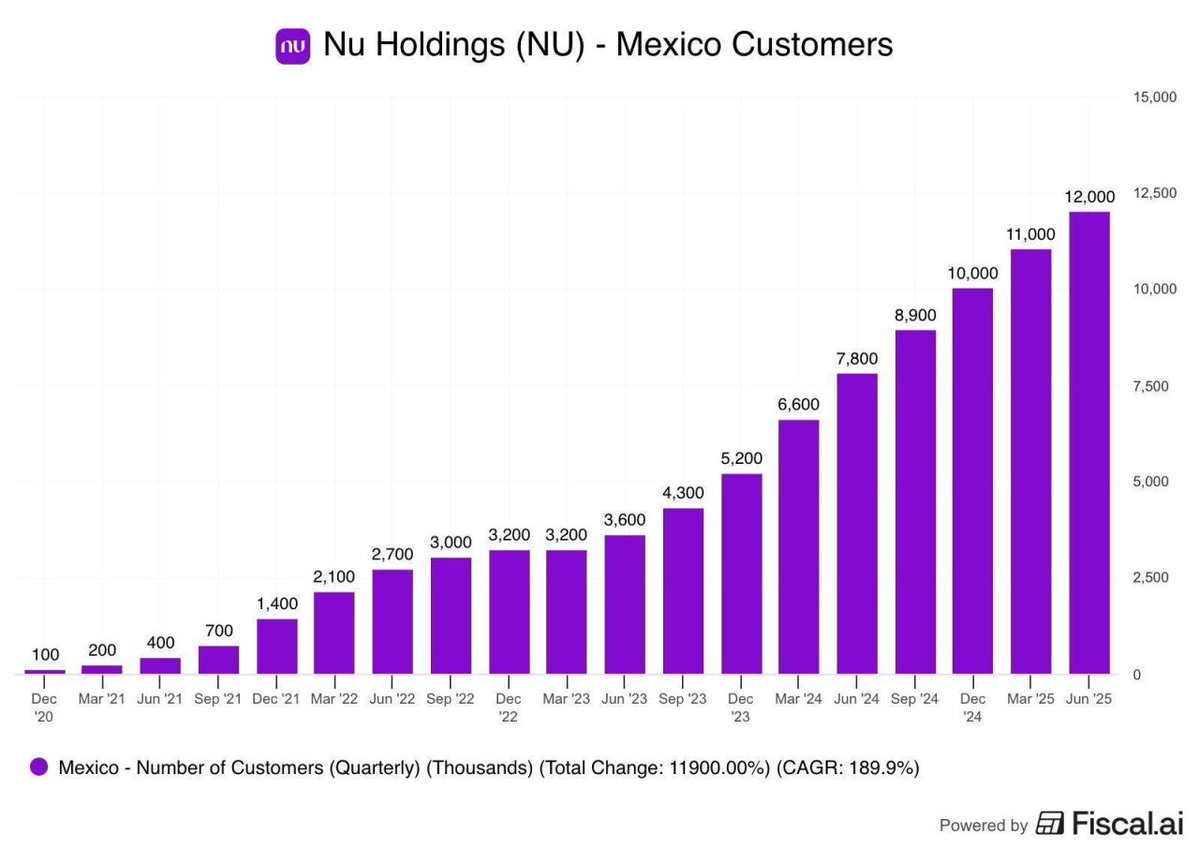Nubank went from launching in Mexico in 2020 to 12 million customers by mid-2025. Now they're applying for a US bank charter.
Can they repeat the trick?
Most people see Nubank as a Brazil story.
But Mexico is the untold story—and it reveals how they actually win.
---
Here's what matters:
- Monthly ARPAC: ~$11 (more mature cohorts at $25)
- Cost to serve: $0.80 per customer
- Customer acquisition cost: ~$5-6 (80% organic through word-of-mouth)
- Activity rate: 83%+
- Efficiency ratio: sub-30% (vs 50%+ for traditional banks)
Mexico specifically:
- 10M customers as of Jan 2025 (12M by July)
- Doubled customer base in 12 months
- Now serving 25% of Mexico's banked population
- 3rd largest in credit cards issued
~50% of customers got their first credit card from Nubank
Full banking license approved April 2025
---
The US expansion is real:
- Applied for OCC national charter Sept 2025
- Cristina Junqueira (co-founder) relocated full-time to lead it
- 122M+ customers across Brazil, Mexico, Colombia as the foundation for remittances
---
What traditional bank CEOs miss:
They see Nubank's "single global platform" and "single data platform" and try to copy it.
They get the what.
They miss the how.
- It's not abstracting mainframes and calling it "global."
- It's not forcing one data model on every market.
It's:
- 100% cloud-native from day one
- Custom data pipelines for credit models and personalization
- Product-market fit first, scale second
- Credit cards before checking accounts (the hardest vertical first)
- 80-90% customers acquired through referrals, not paid marketing
- 60% of customers use Nubank as primary bank
- Capital discipline — <5% of revenue on marketing, 4x that on R&D
---
The US market is brutally competitive.
But Nubank's Mexico playbook shows something rare: unit economics that improve in new markets.
Mexico's customer engagement and revenue curves grew faster than Brazil at the same maturity stage.
That's what happens when you arrive with battle-tested tech, proven risk models, and a decade of learning compressed into the launch.
The real question isn't whether Nubank can compete in the US.
It's whether US incumbents are ready for a competitor that knows how to build a bank for 122 million customers while spending $0.80 to serve each one.
Ac
Can they repeat the trick?
Most people see Nubank as a Brazil story.
But Mexico is the untold story—and it reveals how they actually win.
---
Here's what matters:
- Monthly ARPAC: ~$11 (more mature cohorts at $25)
- Cost to serve: $0.80 per customer
- Customer acquisition cost: ~$5-6 (80% organic through word-of-mouth)
- Activity rate: 83%+
- Efficiency ratio: sub-30% (vs 50%+ for traditional banks)
Mexico specifically:
- 10M customers as of Jan 2025 (12M by July)
- Doubled customer base in 12 months
- Now serving 25% of Mexico's banked population
- 3rd largest in credit cards issued
~50% of customers got their first credit card from Nubank
Full banking license approved April 2025
---
The US expansion is real:
- Applied for OCC national charter Sept 2025
- Cristina Junqueira (co-founder) relocated full-time to lead it
- 122M+ customers across Brazil, Mexico, Colombia as the foundation for remittances
---
What traditional bank CEOs miss:
They see Nubank's "single global platform" and "single data platform" and try to copy it.
They get the what.
They miss the how.
- It's not abstracting mainframes and calling it "global."
- It's not forcing one data model on every market.
It's:
- 100% cloud-native from day one
- Custom data pipelines for credit models and personalization
- Product-market fit first, scale second
- Credit cards before checking accounts (the hardest vertical first)
- 80-90% customers acquired through referrals, not paid marketing
- 60% of customers use Nubank as primary bank
- Capital discipline — <5% of revenue on marketing, 4x that on R&D
---
The US market is brutally competitive.
But Nubank's Mexico playbook shows something rare: unit economics that improve in new markets.
Mexico's customer engagement and revenue curves grew faster than Brazil at the same maturity stage.
That's what happens when you arrive with battle-tested tech, proven risk models, and a decade of learning compressed into the launch.
The real question isn't whether Nubank can compete in the US.
It's whether US incumbents are ready for a competitor that knows how to build a bank for 122 million customers while spending $0.80 to serve each one.
Ac

• • •
Missing some Tweet in this thread? You can try to
force a refresh








